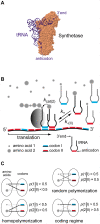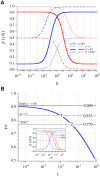Emergence of a code in the polymerization of amino acids along RNA templates
- PMID: 19492048
- PMCID: PMC2685977
- DOI: 10.1371/journal.pone.0005773
Emergence of a code in the polymerization of amino acids along RNA templates
Abstract
The origin of the genetic code in the context of an RNA world is a major problem in the field of biophysical chemistry. In this paper, we describe how the polymerization of amino acids along RNA templates can be affected by the properties of both molecules. Considering a system without enzymes, in which the tRNAs (the translation adaptors) are not loaded selectively with amino acids, we show that an elementary translation governed by a Michaelis-Menten type of kinetics can follow different polymerization regimes: random polymerization, homopolymerization and coded polymerization. The regime under which the system is running is set by the relative concentrations of the amino acids and the kinetic constants involved. We point out that the coding regime can naturally occur under prebiotic conditions. It generates partially coded proteins through a mechanism which is remarkably robust against non-specific interactions (mismatches) between the adaptors and the RNA template. Features of the genetic code support the existence of this early translation system.
Conflict of interest statement
Figures






Similar articles
-
The scenario on the origin of translation in the RNA world: in principle of replication parsimony.Biol Direct. 2010 Nov 27;5:65. doi: 10.1186/1745-6150-5-65. Biol Direct. 2010. PMID: 21110883 Free PMC article.
-
The primordial tRNA acceptor stem code from theoretical minimal RNA ring clusters.BMC Genet. 2020 Jan 23;21(1):7. doi: 10.1186/s12863-020-0812-2. BMC Genet. 2020. PMID: 31973715 Free PMC article.
-
Theoretical minimal RNA rings mimick molecular evolution before tRNA-mediated translation: codon-amino acid affinities increase from early to late RNA rings.C R Biol. 2020 Jun 5;343(1):111-122. doi: 10.5802/crbiol.1. C R Biol. 2020. PMID: 32720493
-
Chemical interactions between amino acid and RNA: multiplicity of the levels of specificity explains origin of the genetic code.Naturwissenschaften. 2002 Dec;89(12):542-51. doi: 10.1007/s00114-002-0377-0. Epub 2002 Nov 7. Naturwissenschaften. 2002. PMID: 12536275 Review.
-
The origin of the genetic code: amino acids as cofactors in an RNA world.Trends Genet. 1999 Jun;15(6):223-9. doi: 10.1016/s0168-9525(99)01730-8. Trends Genet. 1999. PMID: 10354582 Review.
Cited by
-
The stereochemical basis of the genetic code and the (mostly) autotrophic origin of life.Life (Basel). 2014 Dec 16;4(4):1013-25. doi: 10.3390/life4041013. Life (Basel). 2014. PMID: 25522252 Free PMC article. Review.
-
The Ancient History of Peptidyl Transferase Center Formation as Told by Conservation and Information Analyses.Life (Basel). 2020 Aug 5;10(8):134. doi: 10.3390/life10080134. Life (Basel). 2020. PMID: 32764248 Free PMC article.
-
Genetic code degeneracy is established by the decoding center of the ribosome.Nucleic Acids Res. 2022 Apr 22;50(7):4113-4126. doi: 10.1093/nar/gkac171. Nucleic Acids Res. 2022. PMID: 35325219 Free PMC article.
-
Induced fit of the peptidyl-transferase center of the ribosome and conformational freedom of the esterified amino acids.RNA. 2017 Feb;23(2):229-239. doi: 10.1261/rna.057273.116. Epub 2016 Nov 22. RNA. 2017. PMID: 27879432 Free PMC article.
-
A universal RNA structural motif docking the elbow of tRNA in the ribosome, RNAse P and T-box leaders.Nucleic Acids Res. 2013 May 1;41(10):5494-502. doi: 10.1093/nar/gkt219. Epub 2013 Apr 10. Nucleic Acids Res. 2013. PMID: 23580544 Free PMC article.
References
-
- Berg P, Bergmann FH, Ofengand EJ, Dieckmann M. Enzymic synthesis of amino acyl derivatives of ribonucleic acid. J Biol Chem. 1961;236:1726–1734. - PubMed
-
- Gromadski KB, Rodnina MV. Kinetic determinants of high-fidelity tRNA discrimination on the ribosome. Mol Cell. 2004;13:191–200. - PubMed
-
- Lehmann J. Physico-chemical constraints connected with the coding properties of the genetic system. J theor Biol. 2000;202:129–144. - PubMed
MeSH terms
Substances
LinkOut - more resources
Full Text Sources

